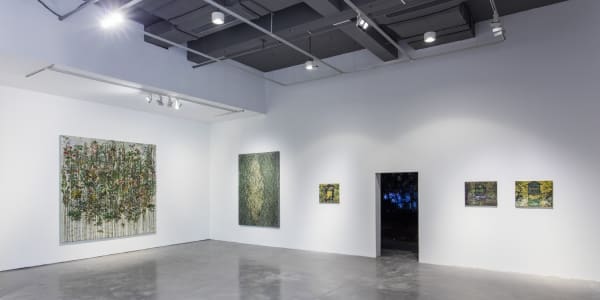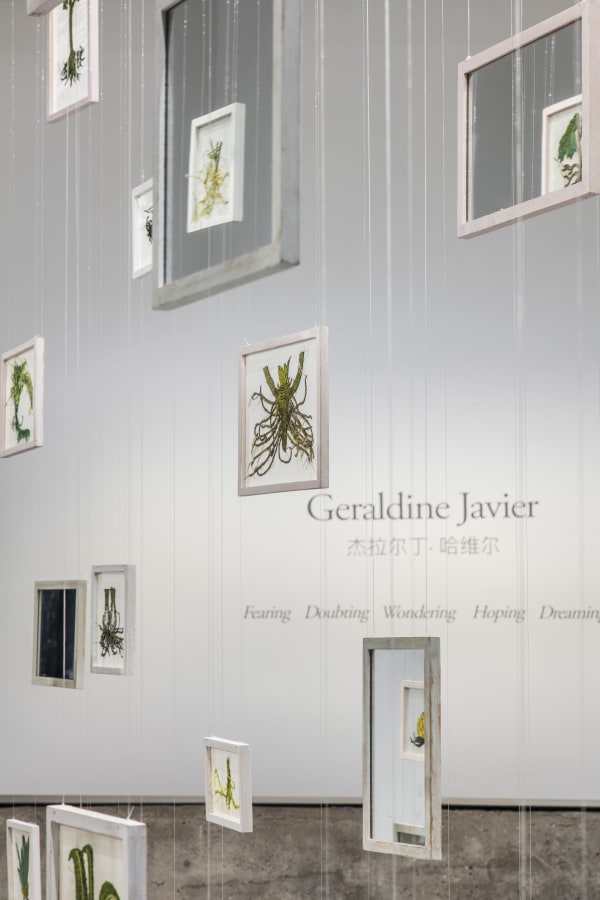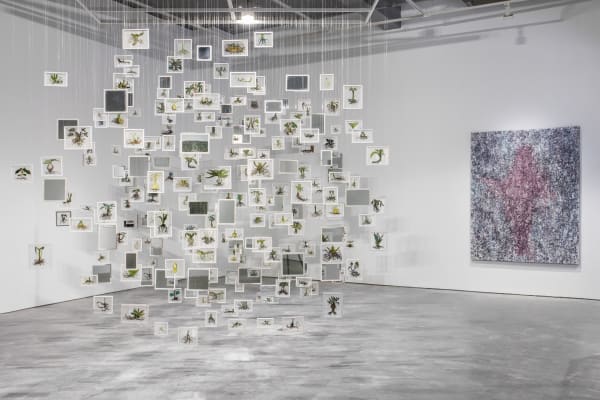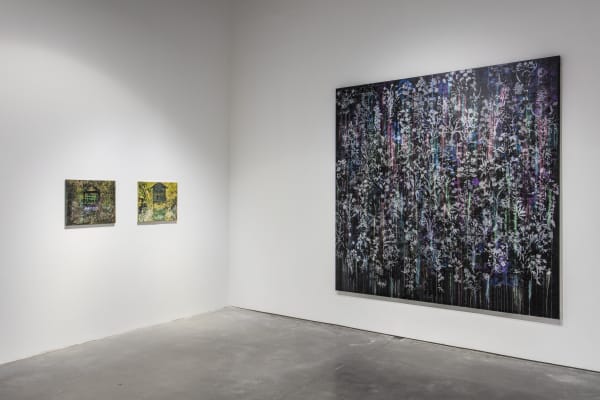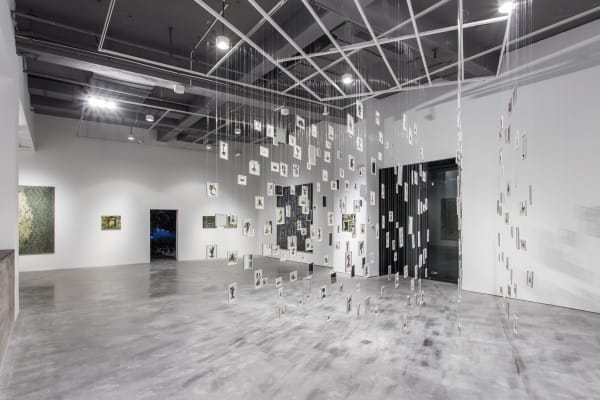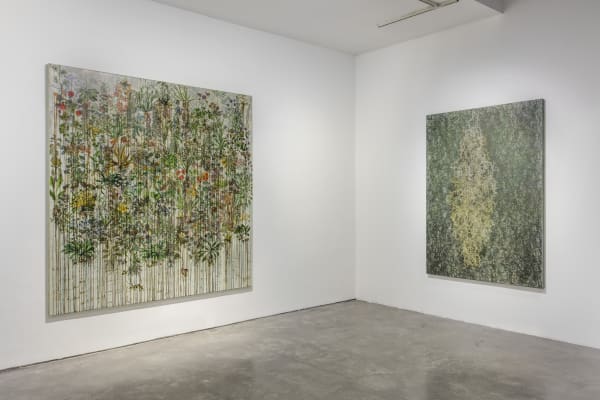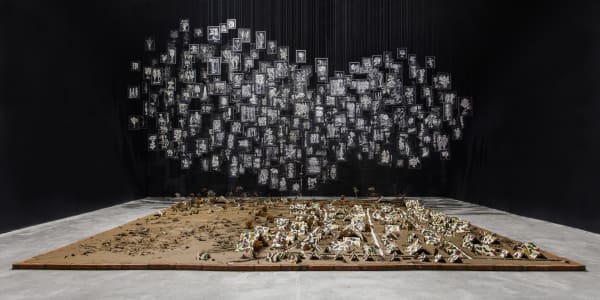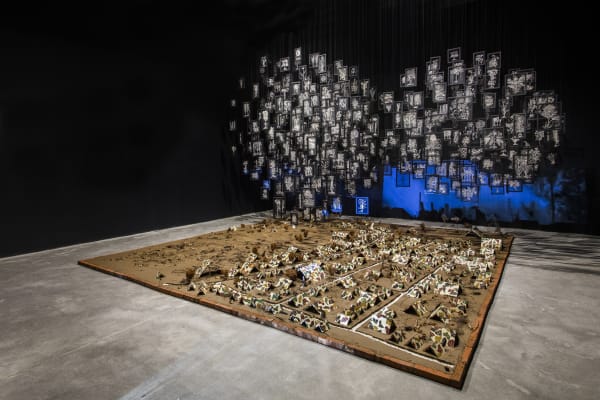제랄딘 하비에르: Fearing, Doubting, Wondering, Hoping, Dreaming
Past exhibition
Press release
Images of flowers and plants fill the large paintings and installations in this exhibition. Seems like a simple attractive scene at the first sight, however, the aesthetics, ideas and emotions involved in Geraldine Javier’s works leaves viewers with a sophisticated and complex perception.
The rich and compelling vision of Geraldine Javier (B. 1970, Philippines) makes her recognizable through East Asia artists. In the early years of her career, Geraldine’s works often focused on isolated figures, sometimes melancholy or morbid, but often touched with a quirky sense of humour. In recent years, she has started using inks and liquid acrylic rather than oil paint. Increasingly, her interest is in an exploration and experience of color, light and space. She has always made installations in tandem with her paintings and these are now filled with embroideries of plants.
Once she was known as a figurative painter, and recently she is more focusing on the nature. She left the congested metropolis of Manila a few years back to live in the mountains in the south side of the city. There she has built a garden on the edge of the jungle.
This is Geraldine Javier’s first solo show in China and the first time that the artist doesn’t include figures in her work – though two do appear, like ghosts, as shadows. Instead of this, there are over a thousands of plant studies: Flowers to be painted and formed one over another one on the canvas, with additional washes and marks, which appears to be a cloud of flowers. Meanwhile, in the installations, each plant is embroidered and framed separately. Hanging from the ceiling, these plants seemingly to float in the air and eventually shape themselves to a form of clouds.
These works are beautiful. There are so many details and crafts to delight in. But, despite the presence of diversified plants, rather than traditional flower paintings, Geraldine’s works are more like abstract paintings such as Jackson Pollock. They are immersive, especially the installation in which one can enter. One is invited to lose oneself in them, or gain a different sense of being.
In addition, the exhibition also pays homage to two late artists — the Cuban artist Ana Mendiata and the English film-maker Derek Jarman, who have passed away before their time. In their art creation, they both utilize nature and gardens to express a view of the world and a way of living. Geraldine shows her admire via one large painting, which is dedicated to the gardeners of Kabul who even during the civil war risked the flying bullets to nurture and care for their gardens.
These works were made in a world facing ecological crisis devastation; the exhibition is both about our love and need for flowers and plants, and the fear of losing them – that they may float away. The French philosopher Voltaire famously finished his philosophical novel Candide with the retort, “let us now cultivate our garden.” For him, the garden was not a place to hide and escape reality, but a metaphor for compassion, responsibility and pragmatism – a call to improve his immediate surroundings. The same is true of this exhibition.
The rich and compelling vision of Geraldine Javier (B. 1970, Philippines) makes her recognizable through East Asia artists. In the early years of her career, Geraldine’s works often focused on isolated figures, sometimes melancholy or morbid, but often touched with a quirky sense of humour. In recent years, she has started using inks and liquid acrylic rather than oil paint. Increasingly, her interest is in an exploration and experience of color, light and space. She has always made installations in tandem with her paintings and these are now filled with embroideries of plants.
Once she was known as a figurative painter, and recently she is more focusing on the nature. She left the congested metropolis of Manila a few years back to live in the mountains in the south side of the city. There she has built a garden on the edge of the jungle.
This is Geraldine Javier’s first solo show in China and the first time that the artist doesn’t include figures in her work – though two do appear, like ghosts, as shadows. Instead of this, there are over a thousands of plant studies: Flowers to be painted and formed one over another one on the canvas, with additional washes and marks, which appears to be a cloud of flowers. Meanwhile, in the installations, each plant is embroidered and framed separately. Hanging from the ceiling, these plants seemingly to float in the air and eventually shape themselves to a form of clouds.
These works are beautiful. There are so many details and crafts to delight in. But, despite the presence of diversified plants, rather than traditional flower paintings, Geraldine’s works are more like abstract paintings such as Jackson Pollock. They are immersive, especially the installation in which one can enter. One is invited to lose oneself in them, or gain a different sense of being.
In addition, the exhibition also pays homage to two late artists — the Cuban artist Ana Mendiata and the English film-maker Derek Jarman, who have passed away before their time. In their art creation, they both utilize nature and gardens to express a view of the world and a way of living. Geraldine shows her admire via one large painting, which is dedicated to the gardeners of Kabul who even during the civil war risked the flying bullets to nurture and care for their gardens.
These works were made in a world facing ecological crisis devastation; the exhibition is both about our love and need for flowers and plants, and the fear of losing them – that they may float away. The French philosopher Voltaire famously finished his philosophical novel Candide with the retort, “let us now cultivate our garden.” For him, the garden was not a place to hide and escape reality, but a metaphor for compassion, responsibility and pragmatism – a call to improve his immediate surroundings. The same is true of this exhibition.
Installation Views




